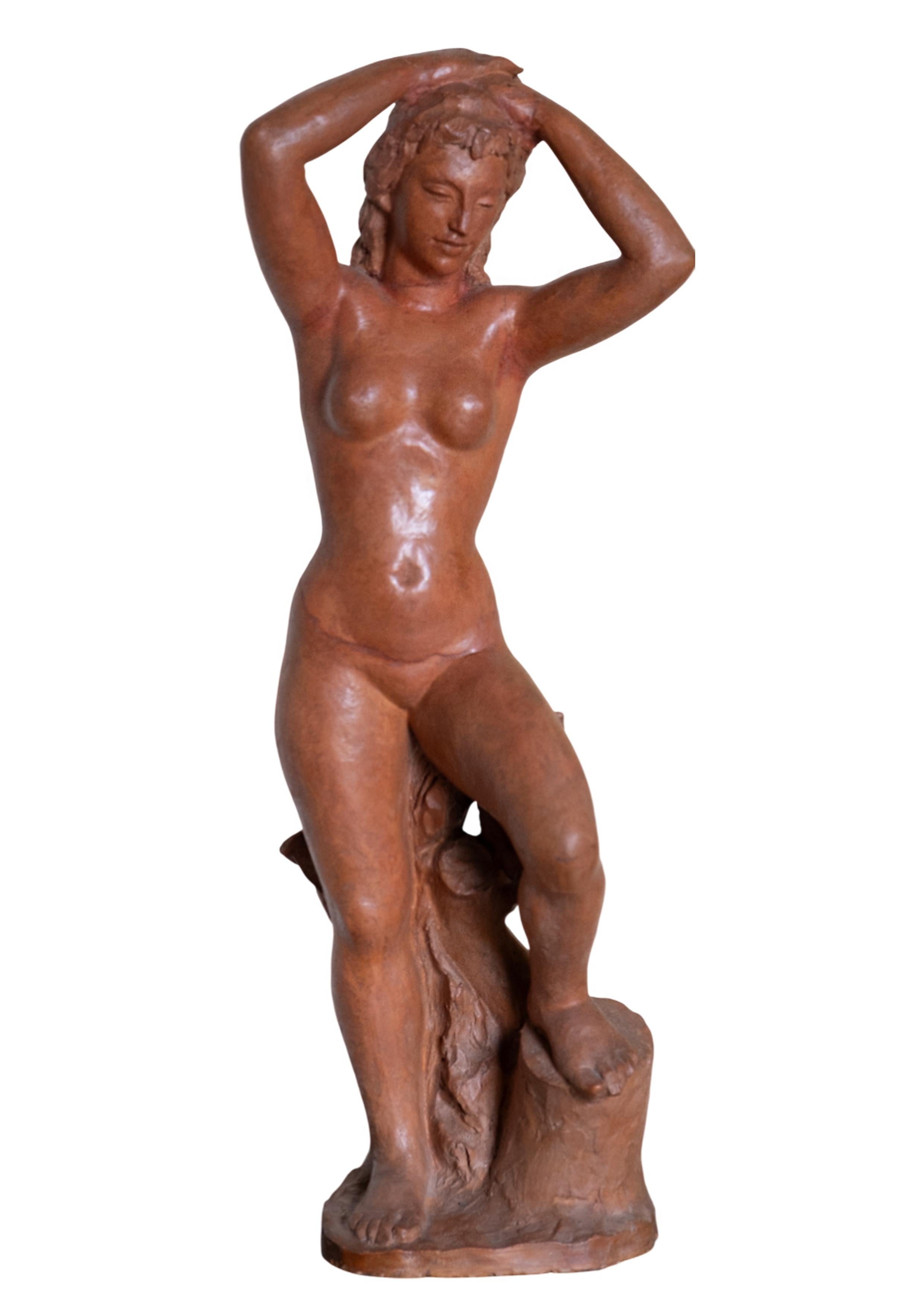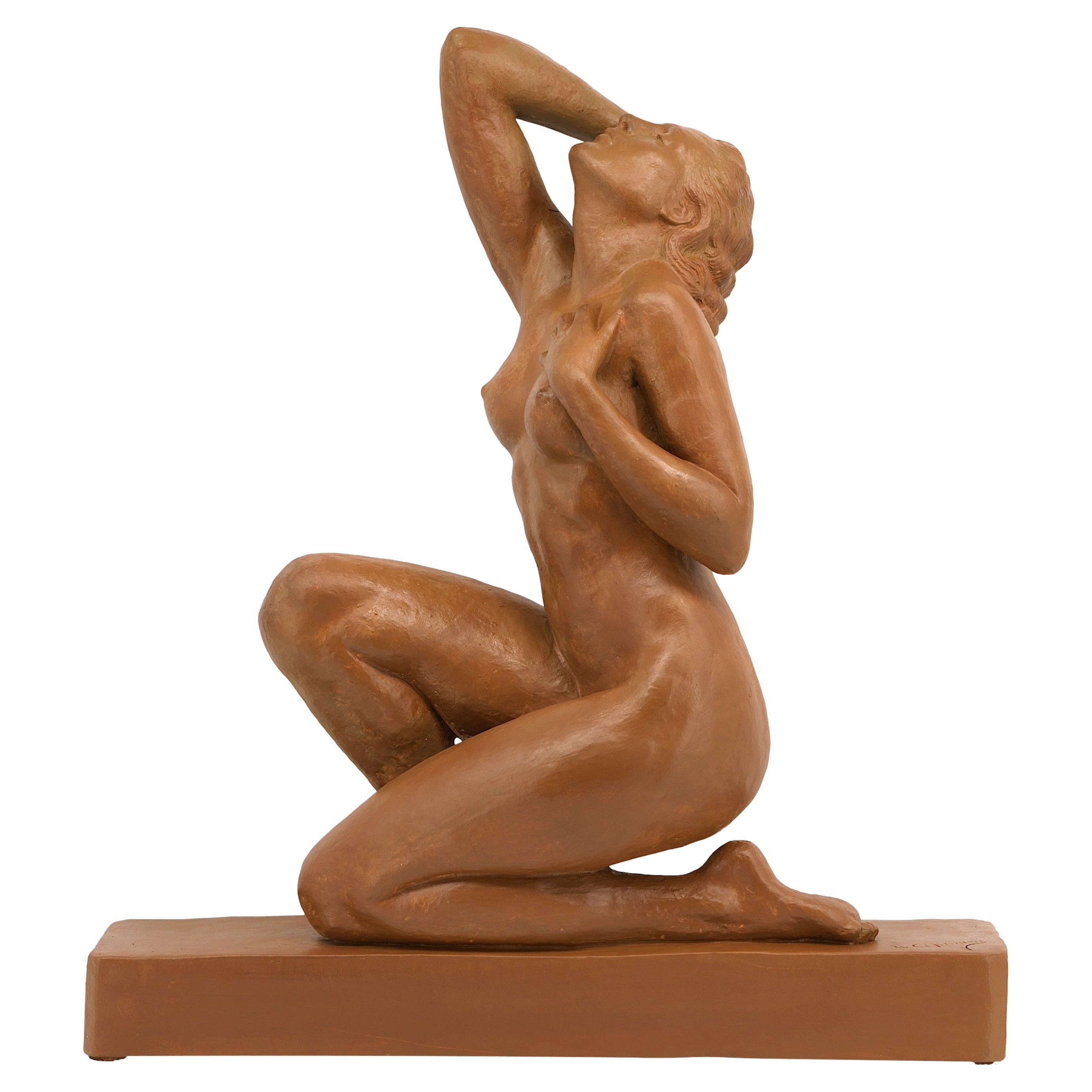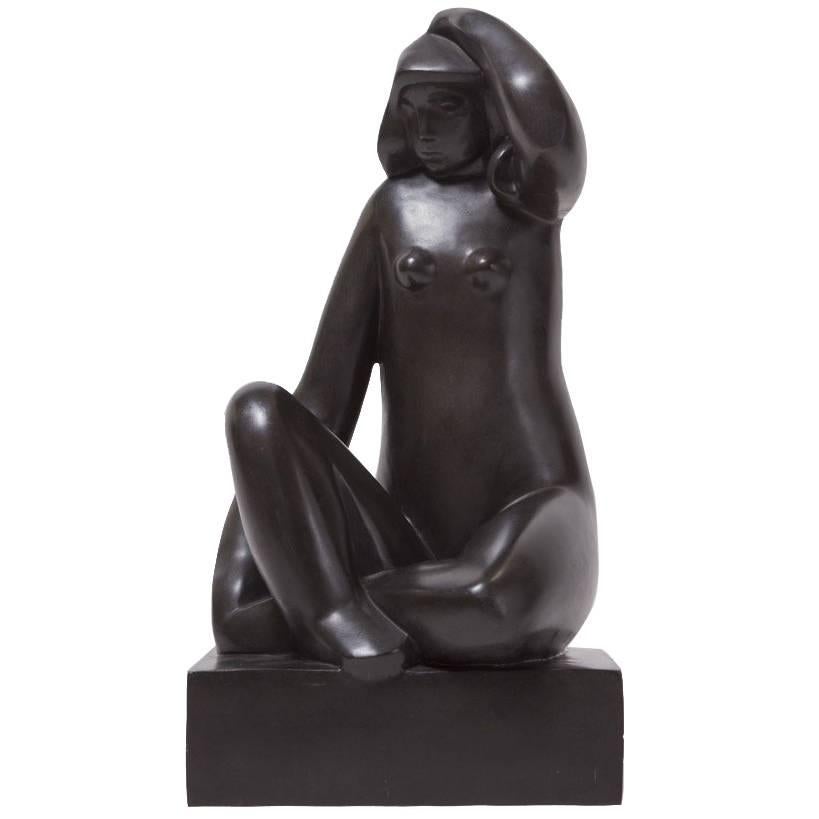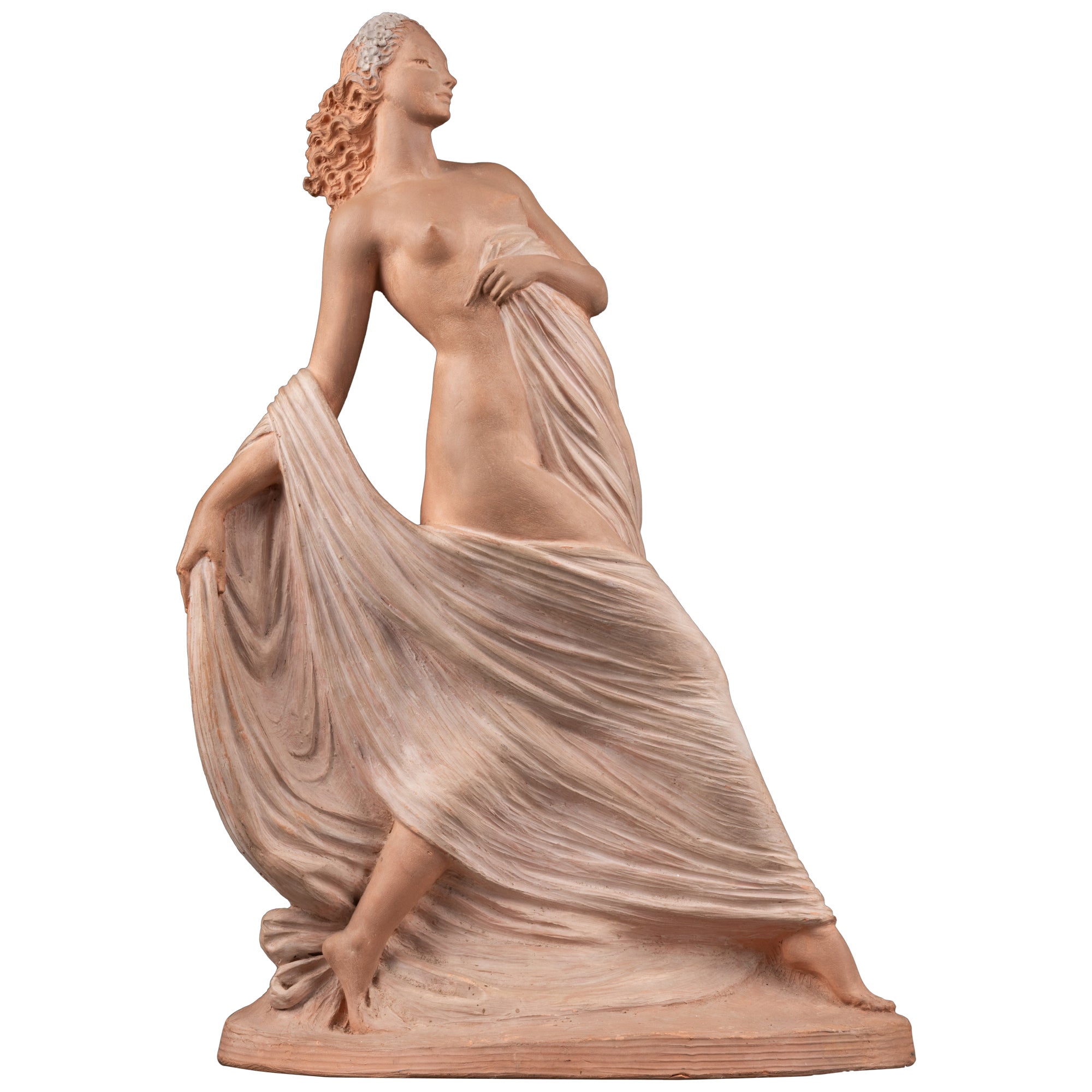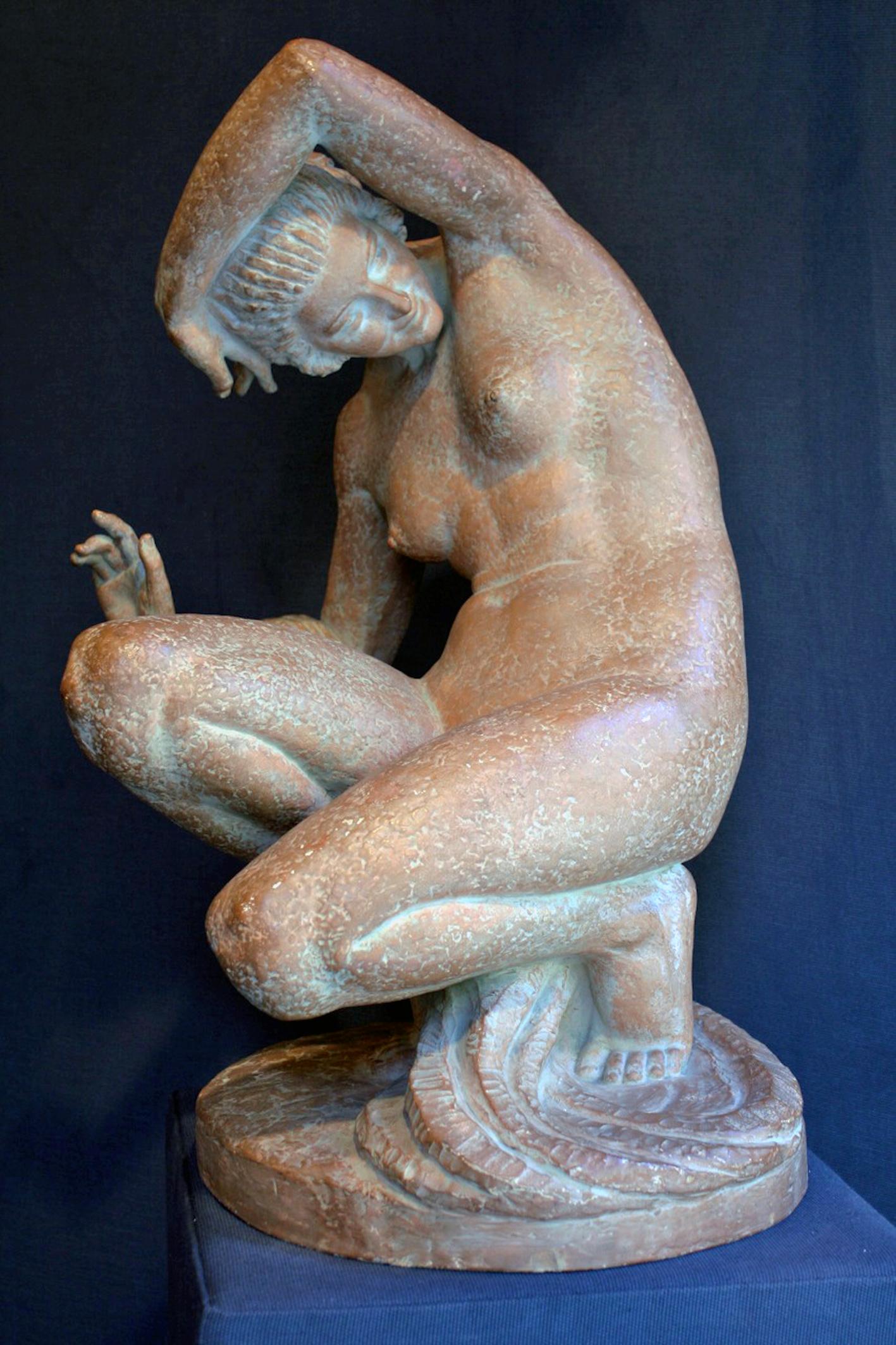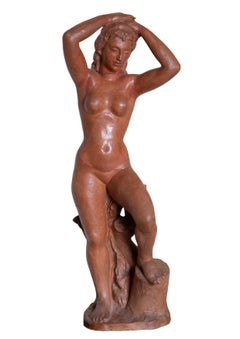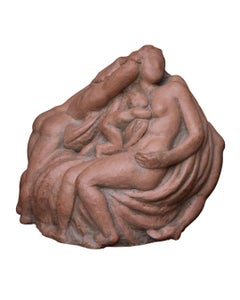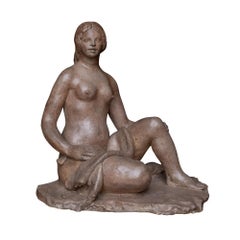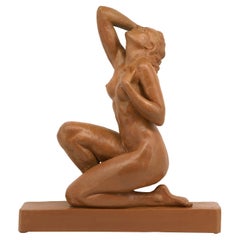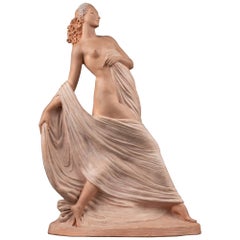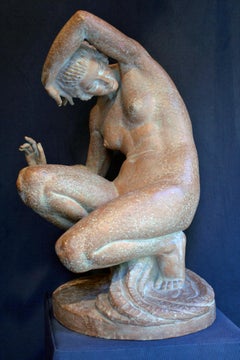Items Similar to Woman with hands above head, terracotta, 1945, Giorgio Rossi (1894-1981).
Video Loading
Want more images or videos?
Request additional images or videos from the seller
1 of 17
Giorgio RossiWoman with hands above head, terracotta, 1945, Giorgio Rossi (1894-1981).1945
1945
$1,747.04
£1,323.42
€1,500
CA$2,420.29
A$2,714.51
CHF 1,421.55
MX$32,983.96
NOK 18,051.27
SEK 17,113.88
DKK 11,420.65
About the Item
Woman with hands above head, terracotta, 1945, Giorgio Rossi (1894-1981), Tuscan Sculptor.
Terracotta sculpture of a nude woman modeled by hand by the artist. Unique piece.
Dimensions: Height 52 cm.
The choice of terracotta as a material, is part of the Tuscan artistic tradition that, from the Etruscan culture to the Renaissance, reflects the bond with the earth, with the clays in the Florentine and Sienese lands. This bond with the past is combined with the modernity of the form.
The sculpture is documented in the catalogues of Giorgio Rossi's collections.
Coming directly from the master's legacy to his family, the work has remained in the collection of his heirs, preserved as a testimony to Rossi's artistic maturity. The work reflects the taste for the balance between tradition and innovation typical of the late Art Deco period, underlining the artist's ability to blend expressive force and formal refinement.
Excellent state of conservation.
Exhibitions: This work belongs to the period in which Rossi participated in prestigious national exhibitions, such as the Venice Biennale (1930, 1936), where his works were praised for their technical quality and ability to interpret modernity without betraying tradition. Artist Biography Giorgio Rossi (1894-1981) was a Tuscan sculptor of great importance, capable of interpreting realism and figurative tradition with a modern sensibility. Born in Florence, he trained at the Academy of Fine Arts under the guidance of Antonio Bortone. His works, often made of terracotta and alabaster, are distinguished by a formal synthesis that celebrates the expressive power of the subject through a modern and refined language. He participated in prestigious exhibitions, including the Venice Biennale (1930, 1936), receiving praise for the technical quality and originality of his works. For over thirty years he taught at the Artistic and Industrial School of Volterra, influencing generations of artists and contributing to the artistic renewal of Tuscany. Rossi's works, often from the family legacy, testify to his contribution to twentieth-century Italian sculpture, with a vision that combines tradition and innovation, Etruscan roots and modern sensibility.
- Creator:Giorgio Rossi (1894 - 1981, Italian)
- Creation Year:1945
- Dimensions:Height: 20.48 in (52 cm)Width: 7.88 in (20 cm)
- Medium:
- Movement & Style:
- Period:
- Condition:
- Gallery Location:Firenze, IT
- Reference Number:1stDibs: LU2464215900682
About the Seller
4.9
Vetted Professional Seller
Every seller passes strict standards for authenticity and reliability
Established in 2016
1stDibs seller since 2023
80 sales on 1stDibs
Typical response time: 3 hours
- ShippingRetrieving quote...Shipping from: Firenze, Italy
- Return Policy
Authenticity Guarantee
In the unlikely event there’s an issue with an item’s authenticity, contact us within 1 year for a full refund. DetailsMoney-Back Guarantee
If your item is not as described, is damaged in transit, or does not arrive, contact us within 7 days for a full refund. Details24-Hour Cancellation
You have a 24-hour grace period in which to reconsider your purchase, with no questions asked.Vetted Professional Sellers
Our world-class sellers must adhere to strict standards for service and quality, maintaining the integrity of our listings.Price-Match Guarantee
If you find that a seller listed the same item for a lower price elsewhere, we’ll match it.Trusted Global Delivery
Our best-in-class carrier network provides specialized shipping options worldwide, including custom delivery.More From This Seller
View AllNude Woman with Hands Above the Head, 1945 Terracotta, signed and dated 1945.
Located in Firenze, IT
Tuscan Sculptor of the 20th Century - Female Nude, Dated 1945
Artist:
Giorgio Rossi (San Piero a Sieve, 1892 - Florence, 1963)
Title of the work:
Nude Woman with Hands Above the He...
Category
1940s Art Deco Nude Sculptures
Materials
Terracotta
Woman with flowers on head, terracotta, 1930s-40s, Giorgio Rossi (1894-1981).
Located in Firenze, IT
Woman with flowers on head, terracotta, 1930s-40s, Giorgio Rossi (1894-1981). Tuscan Sculptor.
Terracotta modeled by hand by the artist. Unique piece.
Dimensions: Height 53 cm.
The...
Category
1930s Art Deco Figurative Sculptures
Materials
Terracotta
Entangled bodies, terracotta sculpture, 1942, Giorgio Rossi (1894-1981).
Located in Firenze, IT
Entangled bodies, 1942.
Terracotta sculpture by Giorgio Rossi (1894-1981).
Tuscan Sculptor.
Material: Hand-modeled terracotta by the artist.
Unique piece.
Dimensions: Height 23 c...
Category
1930s Art Deco Figurative Sculptures
Materials
Terracotta
Seated Female Nude, circa 1930-1940, Giorgio Rossi (1894–1981), Tuscan sculptor
Located in Firenze, IT
Seated Female Nude, circa 1930-1940, Giorgio Rossi (1894–1981), Tuscan sculptor
Period: circa 1930-1940
Artist: Giorgio Rossi (1894–1981)
This sculptu...
Category
1930s Nude Sculptures
Materials
Clay, Terracotta
Woman Laying. Circa 1930-1940, Giorgio Rossi (1894-1981), Tuscan Sculptor
Located in Firenze, IT
Woman Laying, circa 1930-1940, Giorgio Rossi (1894-1981), Tuscan sculptor
Period: Circa 1930-1940
Artist: Giorgio Rossi (1894-1981)
Material: Terracotta
Dimensions: Height 39 cm
Scho...
Category
1930s Art Deco Nude Sculptures
Materials
Terracotta
Portrait of boy, terracotta sculpture, 1930s-40s, Giorgio Rossi (1894-1981).
Located in Firenze, IT
Portrait of boy, terracotta sculpture, 1930s-40s, Giorgio Rossi (1894-1981). Tuscan Sculptor.
Terracotta modeled by hand by the artist. Unique piece.
Dimensions: Height 31 cm.
The...
Category
1930s Art Deco Figurative Sculptures
Materials
Terracotta
You May Also Like
Ugo Cipriani Terracotta Naked Woman, 1920
By Ugo Cipriani
Located in Saint-Amans-des-Cots, FR
Large French Art Deco Terracotta Sculpture by Ugo Cipriani (1887-1960), France, ca.1920. This striking large-scale sculpture by Ugo Cipriani (1887-1960) exemplifies the bold elegance...
Category
Vintage 1920s Art Deco Figurative Sculptures
Materials
Terracotta
Bronze Sculpture "Woman Sitting Hand on Her Head" by Joseph Csaky, 1932
By Joseph Csaky
Located in Paris, FR
Sculpture in bronze with black patina
Signed and numbered. Stamped with the foundry stamp Blanchet and marked AC (Atelier Csaky)
The model from 1932, the present cast is a postmort...
Category
Vintage 1930s French Art Deco Figurative Sculptures
Materials
Bronze
Joe Descomps dit "Cormier": "Woman removing a veil", Terracota sculpture, C.1940
By Joe Descomps Cormier
Located in SAINT-OUEN-SUR-SEINE, FR
Joe DESCOMPS said "Cormier" or Joseph Emmanuel CORMIER orJoseph CORMIER (1869-1950, France) : "Woman removing her veil"
Finely shizzeled and patinated terracota figuring a woman rem...
Category
Vintage 1930s French Art Deco Figurative Sculptures
Materials
Terracotta
Sculpture Terracotta Female Nude From Marcel Bouraine (1886-1948)
By Marcel-André Bouraine
Located in Saint-Ouen, FR
Sculpture Terracotta From Marcel Bouraine (1886-1948)"
Original terra cotta sculpture of Marcel Bouraine
Naïade of the 1930's Signed Bouraine
On the ...
Category
1930s Academic Nude Sculptures
Materials
Terracotta
Nude Seated Woman Terracotta, by Dry Morin 1940-1950 France
By Morin Dry
Located in Beuzevillette, FR
Beautiful representation of a nude woman seated, terra cotta by Morin Dry.
Art Deco
Signed on the base,
1940s.
Category
Mid-20th Century European Art Deco Figurative Sculptures
Materials
Terracotta
$1,455 Sale Price
21% Off
Danish Mid-Century Stoneware Sculpture of a Posing Woman, Anonymous, c. 1970s
Located in Hønefoss, 30
A beautiful stoneware sculpture of a posing woman. Made by anonymous designer in Denmark, c. 1970s.
Wear consistent with age.
Category
Mid-20th Century Danish Mid-Century Modern Figurative Sculptures
Materials
Brass
More Ways To Browse
Head Of A Woman Sculpture
Terracotta Head
Art Deco Woman Sculpture
Art Deco Head Sculpture
Art Deco Terracotta
Sculpture Head Terracotta
Tree Trunk Sculptures
Rossi Vintage
Terracotta Woman
Art Deco Woman Head
Florentine Sculpture
1920s Terracotta
Tuscan Sculpture
Dior Fall 2010
1920s Art Deco Alabaster
Giorgio Milano
Alabaster Woman
Alabaster Head Sculpture
